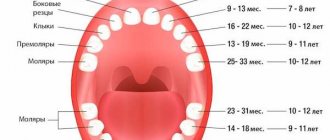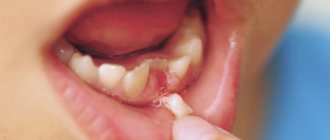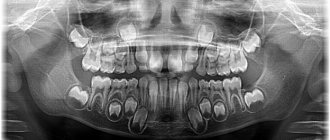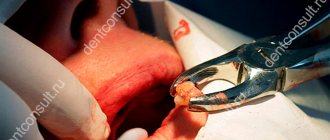Despite the widespread use of digital technologies, in the modern world there is still a place for folk signs, customs, and superstitions. A special place among them is occupied by stories related to children's milk teeth. For example, when the first incisor appears, it was customary for many nations to give a child a silver spoon and be sure to tap it on the emerging tooth. This meant that the baby was ready to meet adult food. Moreover, it was necessary to feed him with this silver spoon. Many signs are associated with their loss.
We’ll tell you where to put baby teeth and whether they can be stored in our article. We will definitely dwell on the interesting signs and traditions of the peoples of the world that have survived to this day.
When does baby teeth change?
The moment when a baby’s lower incisors, as a rule, begin to loosen, can safely be called one of the most exciting in the lives of both children and their parents. Typically, a child's first tooth falls out at the age of 6-7 years. This time for most children coincides with the beginning of school life. This is where the first sign came from: the first tooth fell out, which means it’s time to go to school.
Do not worry too much if the change from milk units to permanent ones does not occur within the generally accepted time frame. They may vary depending on the individual characteristics of the child, the development of his jaw, and the condition of the oral cavity. In this regard, some children begin to lose teeth at the age of five, while others after seven.
Most often, the loss of milk units is preceded by the growth of “sixes”. First, the lower incisors begin to loosen, then the upper ones. That is, their change occurs in the same sequence as growth. So parents have enough time to figure out where to put their baby teeth.
Signs and rituals associated with the first erupted tooth
The eruption of the first teeth in infants rarely occurs without pain, whims and tears. This period is a difficult test for parents who go to great lengths to calm the baby. Great-grandmothers solved such problems with the help of household magic. They hung talismans near the cradle and gave the children the charmed objects to chew on. The amulets helped babies grow strong and healthy. For example, a wolf's fang allowed a boy to grow up brave and wise.
Nowadays, few people adhere to such customs, but the emergence of the first tooth in newborns is always significant. According to an ancient tradition, when the baby is born, he is given a silver spoon. The gift should be presented by the person who first noticed the tooth. However, the tradition is sometimes broken, and the baby receives cutlery from grandparents, godparents, and family friends.
Why is a spoon made of silver presented? It is believed that this metal can bring prosperity and good luck to the owner, and protect him from evil people. Modern scientists have found another explanation. The high bactericidal properties of silver help the child grow healthy (provided that he eats with such a spoon).
In the old days, utmost attention was paid to how the first tooth erupted; signs and customs associated with this event help determine what the life of a little person will be like:
- When baby teeth cut before 6–8 months, the baby will certainly have a sister or brother. If the baby’s upper incisor, rather than the lower one, came out first, it was believed that his mother would have an early pregnancy.
- If a child’s upper incisor came out first, he can radically change his fate at an older age. He has a strong character and the will to win.
- How many teeth a child has by the time he is one year old, the number of children there will be in his family.
- When teeth are in no hurry to come out by the first year of life, success and wealth await the child. Such children were believed to be lucky and have special talents.
- A gap between the upper incisors is a sign of a successful person. It was believed that it would be easy for its owner to conduct any financial affairs.
If the baby's fang came out first, it promised an unhappy fate. In ancient times, fangs indicated a connection with dark forces, hence such a negative omen. In the old days, unfortunate children were sometimes even killed so that they would not become the embodiment of evil. Superstitious people avoided such kids.
Parents' actions when changing primary incisors
Dentists assure that a child whose first teeth are becoming loose does not need pain relief for this process. Although some parents think differently. In fact, before a tooth begins to loosen, its roots dissolve. But discomfort and pain can be caused by a wound formed at the site of a fallen tooth.
Parents of a child whose first tooth has just fallen out can help by:
- Explain that the process of loss is another stage of growing up. Now the child has become very big and can be proud of it.
- Take care of your oral hygiene by rinsing your mouth with a soda solution.
- Warn the child that the wound formed at the site of a lost tooth should not be touched with hands, so as not to cause an infection.
- After eating, suggest rinsing your mouth with warm water. Do this until the wound heals.
How can parents help their child?
In any case, the process of losing milk units remains a difficult emotional experience and parents are obliged to help cope with this. And it's not just about fairy tales and stories.
It is important to ensure that no tooth fragment remains in the gum. If you suspect such a problem, be sure to show your baby to the dentist. Also pay close attention to the wound that appears. It usually bleeds for a while. Therefore, you should make a cotton or gauze swab, put it in place of the lost tooth, and after a few minutes everything will stop.
We invite you to familiarize yourself with Removable dentures, inexpensive prices in Balashikha, photos on || Balashikha
Immediately after the milk unit falls out, you can ask the child to rinse his mouth with a weak soda solution. It will disinfect the wound, wash away food debris and speed up healing. Ask your baby not to touch this area with his tongue. A blood clot should form there, which should not be removed.
Most children begin to change their teeth at the age of five. At the same time, it was noticed that the earlier they erupted in the baby, the sooner they will begin to change.
As a rule, the first one to appear is the one that appeared first. Further, the order of shifts varies, but this does not mean anything.
Most often, the order in which baby teeth are replaced by molars looks like this:
- lower central incisors;
- upper central incisors;
- lateral incisors;
- molars.
The process of replacing all baby teeth with molars can take 6-8 years. This is individual for each child. But there are still some factors that can affect this process. These include:
- genetic characteristics of the child;
- diet;
- possible dental diseases;
- the quality of the water your baby drinks.
When parents see a loose tooth in their child, they begin to worry that the baby is experiencing discomfort or even pain. But this is far from true. The only thing is that this process arouses interest in the child. Therefore, he may try to loosen it with his fingers or tongue.
Adults should explain to him that it is unsafe to do this, as infection can get there. Just wait a little and everything will happen by itself.
And when this happens, the wound needs to be disinfected with a weak soda solution. By rinsing your mouth with this solution just a few times, the wound will heal.
For a child, the moment of losing a tooth is fraught with fear. Especially if this process is caused by minor bleeding or a broken fragment. If parents discover that there is a splinter left in the gum, then they should contact the dentist immediately.
To save your baby from possible discomfort, it is recommended to rinse the mouth with water and soda solution. After each meal, also rinse your mouth with warm liquid and ask your child not to touch the wound with his tongue.
In other cases, when the prolapse is not associated with particularly unpleasant moments, you can tell the baby an interesting story or fairy tale. It could be about a mouse or a fairy who takes a tooth and in return grants a wish or brings a coin or a delicious, favorite candy. While telling a story or fairy tale, parents can show their permanent teeth so that the child understands that the smile will soon become beautiful again, as before.
Or you can come up with your own unique story about a magical house-elf who collects the fallen teeth of all family members, and then compares who has the healthiest and whitest ones. By getting your child interested, you will help him get through a difficult period.
There are times when a child may accidentally swallow a lost tooth. And if parents have such suspicions, it is still recommended to consult a doctor to find out whether there is a splinter left in the gum.
And if there is slight bleeding at the wound site, then you can use a piece of gauze, from which you should form a small tourniquet, place it on the wound area and ask the baby to bite it. The bleeding will soon stop.
Parents perceive the process of growing up their own child with special trepidation. Particularly important for many is the moment when a child’s baby teeth begin to fall out. Moms and dads should try to distract the baby from the very fact of what happened so that he does not experience any fears because of what is happening. Here you can use all your ingenuity and imagination so that not the most pleasant process becomes an exciting and memorable event.
Fairy tales, stories and myths help a child overcome fear, which will add confidence and peace of mind in later life.
When a child appears in the family, the peace of parents comes to an end. The baby experiences dental problems especially hard. At first, their appearance, which parents really look forward to, causes discomfort. Another problem is changing dairy products to regular ones. The teeth gradually begin to fall out one by one. This is where the question arises: what to do with a lost baby tooth?
When do baby teeth fall out?
The process of replacing all baby teeth with a permanent bite occurs individually for each child. Drop times may also vary slightly. In most cases, the first tooth falls out at 6-7 years of age, but slight deviations from the norm are possible. Everything will depend on the development of the child’s jaw apparatus and how healthy the baby teeth are.
The milk teeth begin their formation in the womb, but the permanent bite begins its development after the birth of the child. The period of change from primary to permanent teeth will depend on how quickly the rudiments of permanent teeth are formed.
Many parents are lost and do not know at all what to do with their beloved child’s already fallen milk teeth. Some people, not knowing where to put the first baby tooth that falls out, simply hide it in a box with memorabilia. Others give their teeth to a mouse or fairy.
Milk and permanent teeth also differ from each other. In a primary dentition, a child grows only 20 teeth, 10 on each jaw. When a permanent bite is formed, the jaw grows and expands. There are already 32 permanent teeth. Many parents believe that changing the bite is quite painful for the child. But the whole point is that before they fall out, all the roots in the milk bite dissolve.
The teeth loosen on their own and fall out completely painlessly. However, when changing teeth, there is also a danger of the child swallowing it.
Do I need to see a doctor?
Ideally, when baby teeth are replaced, they fall out on their own, meaning no removal is required. But in 80% of cases everything turns out a little differently. The permanent tooth begins to emerge after the milk tooth, when it has not yet fallen out. And since he encounters an obstacle on his way, he changes his direction in the wrong direction. Subsequently, this leads to the formation of an incorrect bite in the baby.
To help the baby tooth leave its place faster and free up the permanent one, you need to consult a doctor. Only a competent specialist can surgically remove a unit of dentition correctly. If you try to do this yourself at home, you can damage the gum mucosa and provoke the development of an inflammatory process. You may also need the help of a dentist in the following atypical situations:
- with swelling and severe pain in the gums;
- with bleeding and long wound healing;
- when a tooth is broken or severely damaged;
- in case of ingestion of a unit of the series.
As soon as a child’s tooth begins to loosen, he is most often in high spirits. Very soon the child will be able to show off to his friends how grown up he has become. At this very moment, parents are overcome by another problem, namely, where to put their baby teeth. You should think about this in advance.
A tooth is broken - what's the point?
In signs about lost and broken teeth, not only their damage is taken into account, but also the features of the event:
- It matters how the tooth was lost by an adult: during a meal, in a fight, or other circumstances;
- the nature and strength of pain and blood loss are taken into account;
- it is important which tooth is damaged (loss of wisdom teeth was considered the most dangerous).
According to the signs, if a tooth breaks, this promises a person the following dangers:
- says that there are many envious people around, so none of the people can be trusted;
- tooth loss with blood warns of the loss of a relative or friend;
- predicts the approach of a long illness;
- promises separation from a loved one, betrayal of a significant other;
- loss of a tooth by one of the spouses shortly after the wedding is a warning about a barren marriage or frequent quarrels during their life together;
- a chipped baby tooth is a sign that the child will have problems with friends, which will require parental intervention.
When a tooth breaks off and the damage is minor, signs predict the following imminent events:
- if a person resolves complex issues at this time, goes to court, argues with opponents, the situation will not be resolved in his favor;
- when a piece of a molar breaks off, you should soon prepare for the loss of some of your material wealth;
- a hole in a tooth speaks of causing damage, envious people around a person.
Where to put a lost baby tooth?
As you know, in most children the lower primary incisors are the first to leave the dentition. And even if this event did not happen at home, but in a dental clinic, the doctor is obliged to give the child his tooth. And already at home, mom and dad will decide for themselves what to do with the child’s fallen baby teeth. But most parents don’t dare throw it in the trash.
Many mothers carefully store objects that remind them of the first years of their baby's life. These include an ultrasound picture taken during pregnancy, a tag from the maternity hospital, and the first curl cut at 1 year. It is along with these things that most mothers prefer to store the first tooth that falls out.
If parents are superstitious enough, they can conduct a real ritual of farewell to the milk element with their child, which he will remember for the rest of his life and will be able to pass on this tradition to his children. To do this, you should get acquainted with the signs of different peoples of the world in advance.
Have toothache – treat or interpret?
To avoid becoming a victim of superstitions, you should:
- give up risky projects and trips over the next month;
- resolve conflicts with loved ones and colleagues;
- remember deceased relatives;
- ask forgiveness from everyone who was unfairly offended;
- take up your favorite hobby;
- travel out of town, to the mountains or to a body of water more often.
No matter how you interpret the signs of fate, it is impossible to endure toothache. If your teeth hurt, you should contact a dental clinic. Fear of the dentist and the drill is not an excuse for inaction. Currently, doctors have dozens of techniques at their disposal that can help undergo any dental intervention. The only problem is financial limitations. In this case, help can be provided at a municipal clinic.
Dentists know only one sure thing that can protect you from the bad influence of omens: take time for yourself, make an appointment with a dentist and undergo a comprehensive examination. Failure to treat diseased teeth leads to the spread of infection in the oral cavity. This threatens pulpitis, periodontitis, gum inflammation, cyst formation and other serious problems. Treating a tooth in a timely manner means saving yourself from sleepless nights, regular use of painkillers and bad mood.
Is it possible to store baby teeth?
Until recently, it was believed that elements of the dentition that had fallen out independently or surgically removed should be immediately disposed of. Black magicians, witches and sorcerers could steal them from home and plot or damage them. That's why parents didn't stand on ceremony about where to put their baby teeth. They were thrown away or buried deep in the ground.
Today, the opinion about methods of disposal of fallen baby teeth has changed dramatically. The fact is that British scientists have learned to extract stem cells from pulp. It has been proven that their potential is much stronger than biomaterial taken from the umbilical cord of a newborn. To find out more about this, parents can contact a stem cell storage bank. Biomaterial is stored in this medical institution at a temperature of -196 °C. Frozen cells can later be used in the treatment of serious diseases, including bone marrow transplantation.
Wisdom teeth in popular beliefs
According to legend, the owner of all wisdom teeth is given the opportunity to use the help of his ancestors, so it is easier for him to do everything. Ancient signs call wisdom teeth a lucky sign, foreshadowing wealth, success, and good luck. Moreover, pain and other unpleasant sensations during their eruption were also considered additional happy signs. To preserve molars, they used special rituals to preserve their health and strength.
If a molar was lost in battle or a fight, it was kept as a talisman. The gypsies buried it and waited for wealth to descend on them.
People who never received one or more wisdom teeth may first decide that they are very unlucky. But this happens often today. After all, the jaw of a modern person is narrower than in ancient times.
What to do with a child’s baby teeth: folk signs
From time immemorial, each nation has had its own traditions and customs regarding the storage of fallen child teeth. For example, nomadic tribes always buried them. Therefore, there were no questions about what to do with the child’s baby teeth. The parents had to dig a deep hole, put the tooth in it and cover it with earth. It was believed that this was the only way to protect the baby from damage and misfortune.
The peoples of Britain had their own traditions regarding where to place a child's baby teeth. Folk customs boiled down to preventing damage to a child using a tooth. For this purpose, any milk element of the row was burned immediately after falling out. It was believed that in this case a strong and healthy one would quickly grow in its place.
Another sign common among the British in ancient times is associated with animals. It was believed that the tooth should be destroyed, hidden or buried so that a predator would not get it and eat it. If this happens, the child will grow fangs, like an animal.
Today all these signs seem strange and funny, but our ancestors sincerely believed in them and, worried about the fate of their children, unquestioningly carried out all these actions.
Where do signs, beliefs, customs come from?
Each country has its own signs and superstitions associated with the main event in a child’s life. Sometimes, the customs of peoples are radically different from each other. If your baby has such an important event, you have the right to act in accordance with any traditions.
American traditions
In America there is a belief about a mysterious fairy who flies at night and takes away baby teeth. To do this, they are placed under the pillow, in the hope of finding a long-awaited coin in return. Perhaps this tradition can be considered one of the most famous and widespread.
English traditions
More complex traditions developed among the northern English. There it was believed that a lost tooth must be burned. Firstly, this eliminated the possibility of using it for the purpose of inducing witchcraft and damage, and secondly, they believed that a stronger and healthier one would take the place of the burnt tooth.
Another equally interesting English tradition associated with these things states that a baby tooth must be destroyed in any way so that no animal can swallow it. If this happens, the child will have an ugly smile, or the exact same fangs as those of the animal that swallowed him.
The Slavs had several interesting signs. Most often, the loss was given to the mouse, which was supposed to take it for itself and bring a new one in its place. They also threw their teeth behind the stove and asked the brownie to take them for themselves.
Gypsy traditions
If a child lost a tooth, they either buried it, reciting special spells, or threw it to the moon. It was believed that in this way one could attract good luck, which would accompany the child throughout his life, protecting him from ill-wishers and various troubles.
In Asian countries, there was a funny belief that a new one would grow in place of a lost tooth. At the same time, the fallen upper teeth were thrown onto the roof of the house where the baby lives, the lower ones were hidden under the porch, and the parents repeated a special spell that was supposed to provide the baby with protection from the evil eye.
Folk beliefs and customs arose in the distant past, even when our ancestors were pagans. People knew little about the world around them and were defenseless against the rampant elements. With the help of signs, they tried to protect their family from many things for which they could not find an explanation. We always analyzed what was happening around us, looked for patterns, remembered which events lead to joy and which ones promise failure.
This is how signs arose. Customs and rituals appeared that were supposed to appease the representatives of the other world - good and evil spirits, and help a person survive.
Centuries later, many people also believe in signs of fate and listen to everything that concerns the health of loved ones. Beliefs associated with teeth occupy a special place, because for a long time teeth have been a symbol of strength and strength.
Why give a tooth to a mouse?
Among the Slavic peoples, one of the signs of where to put a baby tooth was associated with throwing the fallen unit behind the stove. This was done for a brownie or a mouse. They had to take the baby tooth and bring the molar tooth in return.
In some European countries, they also adhere to the custom of placing the tooth under the pillow at night. But it’s not the kind tooth fairy with wings and a magic wand in her hands who should take it, but a little mouse. In France she is called La Petite Souris, and in Spain - Perez. Traditionally, at night, an unnoticed little mouse sneaks under the pillow to exchange a tooth for money or treats. Children eagerly await the appearance of this rodent in order to receive something nice as a gift.
Everyday superstitions
Normal jaw development ends with the growth of wisdom teeth, which occurs between the ages of 18 and 27 years. The sooner they get out, the sooner the young girl will get married, and the guy will find what he loves.
The sign promises the young lady a promising marriage with a wise man. If a wisdom tooth is cut on the eve of an important event, it is the key to success. Signs associated with the processes help resolve protracted conflicts - if the gums become inflamed before the trial, controversial issues can be resolved.
Who is the tooth fairy?
In many countries of Northern Europe, America and Canada, they adhere to a different sign about a child’s baby teeth. People here know where to put the dropped element of a row almost from birth. Kids eagerly wait until their tooth begins to loosen so that after it falls out, they can put it under their pillow. In return, the good fairy should bring a coin there. This tradition is one of the most widespread and popular today. By the way, the fairy tale about the tooth fairy and the mouse Perez was invented by the Spanish writer Luis Coloma for the eight-year-old King Alfonso VIII, who lost his first baby tooth.
The myth of the good sorceress is a useful one. It helps the child overcome the fear of a lost tooth and allows him to receive monetary or other pleasant compensation for the loss.
Signs about the loss of permanent teeth
Losing a baby tooth is not scary
Unfortunately, situations sometimes arise in an adult when a permanent tooth falls out. This happens due to injury, stress, illness, and infectious lesions of the oral cavity. If any tooth falls out in an adult, you can expect only the most dire consequences. Signs interpret such an event as a signal of approaching illnesses, problems, even death. The exact interpretation depends on the locality.
Some warn a person whose dental system is collapsing about their imminent participation in a funeral. Other signs consider such an event to be a sign of an approaching separation from a loved one. Still others regard it as an omen indicating an imminent move.
In Tibet, if the dental system is damaged, they talk about an impending disease. A broken crown warns of a quarrel with a friend. When the entire jaw crumbles, pay close attention to the general state of health: this happens during the course of a serious illness.
People often pay attention to what exactly a person has lost: a canine, an incisor or a molar. If a fang or incisor falls out first, the victim is under the evil eye. If this happened unexpectedly and quickly, damage takes effect. There are certain signs associated with a lost wisdom tooth. It is believed that they appear when an adult establishes a strong connection with the family.
If 3 molars do not grow, this is evidence of a person’s lack of ancestral support. If not everyone appears, the connection with the family is weakened or you have to pay for the sins of your ancestors throughout your life, so negative beliefs are associated with a lost wisdom tooth. They promise weakening health, a deterioration in the general state of affairs due to the loss of connection with the family, which is symbolized by the loss of the “eight” (as the 3rd molar, the wisdom tooth, is usually called).
Having an extra wisdom tooth is considered evidence of supernatural abilities. Usually those who have a larger than standard dental system are endowed with fortune-telling talents.
Fallen incisors, fangs, and molars cannot simply be thrown away. This is a biomaterial that can easily damage a person, so getting rid of lost teeth is carried out in accordance with the traditions of their people. Usually they are burned and buried in the ground. This way, a piece of a person will certainly not fall into the hands of sorcerers, but will immediately be returned to higher powers.
After death, the soul has to account for all the lost fangs, molars, incisors, nails, and hair. Until they are collected, the soul will not find peace. If these particles are burned or buried, there is no need to look for them: they go directly to God. Then the ordeals of the soul after death will be less.
Do you need a gift?
Regardless of where the mother decides to put her child’s baby teeth, where to put them or to throw them away altogether, it will be very good if she prepares some surprise for the baby. This will make it easier for him to bear the loss.
If a child puts a tooth under his pillow, the first thing he will do when he wakes up is check to see if the mouse or tooth fairy took his treasure. If yes, then a coin or present should appear in this place. This could be a book, a coloring book, a set of pencils, paints or markers. Parents should choose gifts that can easily fit under the pillow. If the gift is too large, then it will have to be placed next to it.
It is not recommended to give chocolate, sweets and other sweets. The tooth fairy cares about the health of children's teeth, so she should give them only useful gifts. And as you know, sweets quickly begin to deteriorate your teeth. It is better to put a coin under the pillow, and for it the child will buy what he likes.
Traditions of the peoples of Asia
In many Middle Eastern countries, children do not leave their lost tooth to a mouse or fairy. Instead, they throw it up towards the sun. It is believed that this will allow teeth to grow faster and stronger than before.
A similar sign of where to put a lost baby tooth is followed in Japan. To get a new one instead of the old one, you need to make a good straight throw. But the bottom tooth should be thrown up, and the top one down, that is, in the opposite direction.
Relation in real time
Dentists come to the rescue, removing the problem once and for all. Before rushing to the dentist, try to calm the pain with medications or traditional methods. They are fragile and deteriorate faster than others. Sooner or later you will have to remove such a gift. But don’t rush, as he is supposed to receive presents from fate, big and small. Says the sign, echoing through the centuries.
Scientists want to understand why not all people experience pain and discomfort when cutting through the “eights”.
Tooth on the roof
Throwing up fallen milk elements is a fairly common sign among many nations. But children in some countries strive precisely to throw a tooth onto the roof. This is done in Greece, Brazil, Ethiopia, and Sri Lanka. But in China, Korea, Vietnam and India, this is done only with the lower teeth, and the upper ones, on the contrary, are thrown under the bed or even hidden in cracks in the floor. And every baby knows where to put baby teeth.
You need to throw your teeth onto the roof so that a bird or squirrel can grab it faster. Then a new one will very quickly grow in its place. And a tooth under the bed, most likely, can easily be dragged away by a mouse.
There is some truth in every story
What to do in this case? Close your mouth and run to the dentist. Otherwise, if left too long, the wisdom tooth can cause fever, problems with swallowing, and muscle inflammation.
What can the doctor do? First, the dentist will administer anesthesia, then excise the area of gum above the tooth that is poorly erupting. This will ensure the drainage of pus and help the tooth emerge faster. After this, the dentist will prescribe antibiotics and anti-inflammatory drugs. And if everything happens again, then the tooth must be removed.
Maybe the tooth needs to be hidden?
Not everyone wants to give their lost treasures to an animal or some fairy-tale creature. In Nepal it is considered very bad luck if a bird takes a tooth and does something with it. In this country, children come up with their own secret storage places that even adults don’t know about.
In Malaysia, fallen milk teeth are also hidden, but only in the ground. The kids bury them, thus returning them back to nature.
In Turkey, parents believe that with the help of baby teeth they can influence their child’s choice of future profession. So, they bury the fallen elements near the hospital if they want their child to be a doctor, or near the school if they dream of seeing him as a teacher. Football fields are especially popular.
The meaning of dreams
A dream in which a person lost a tooth is interpreted in a special way. Pay attention to the presence of blood. If one or even all the incisors, canines, molars fall out, without blood, they await the death of an acquaintance, friend, neighbor.
If the gum from which a tooth fell out in a dream produces blood, the death of a blood relative is expected. At the same time, it is impossible to determine in advance who will die.
When a fragment of a tooth simply breaks off in a dream, it is advised to take a break. This happens in moments of nervous, physical, mental overstrain, when the energy shell becomes thinner.











